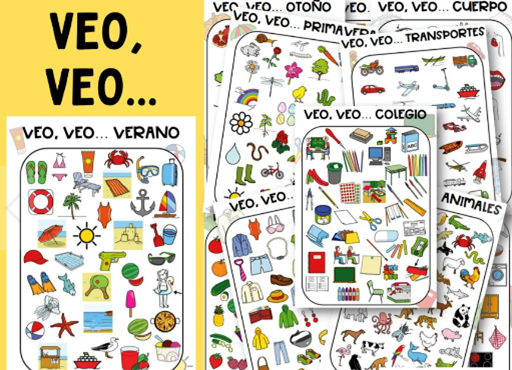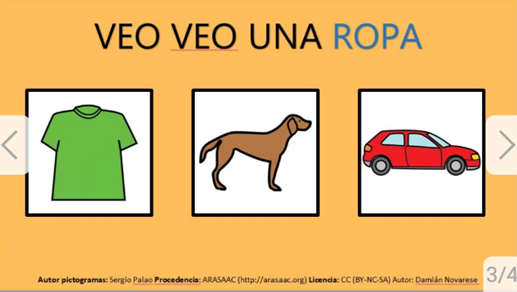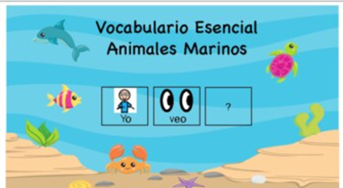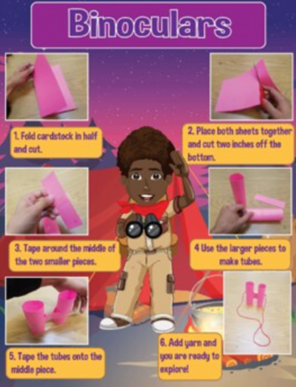Ver/See
WAYS WE CAN USE THE WORD
SHARE INFORMATION: e.g., Yo veo a mi amiga. (I see my friend.)
REQUEST: e.g., ¿Puedo ver ese libro? (Can I see that book?)
EXPRESS A FEELING: e.g., Me encanta ver esa pelicula. (I like to see that movie.)
COMMENT: e.g. No puedo ver el pizarron. (I can’t see the blackboard.)
MOST FREQUENT VERB CONJUGATIONS
|
SUBJECT |
PRESENT |
PAST |
|
I |
Veo |
Vi |
|
You |
Ves |
Viste |
|
He/She/You (Formal) |
Ve |
Vio |
|
We |
Vemos |
Vimos |
|
They/You All |
Ven |
Vieron |
For specific questions or more ideas regarding this core word activity sheet, please contact Isabel de la Luz Medina @ imedina@sfsu.edu. Thank you!
Snack/mealtimes: During mealtime and snack times, the adult can model the word when telling the student to look at what is available as a snack, “Puedes ver lo que está disponible para comer hoy. (You can go see what is available for snack today.")
Circle: During circle or meeting time, students can share what they saw over the weekend at the start of the week. “En el fin de semana yo vi un perro en el parque. (This weekend I saw a dog at the park).

Toys and Games: Students can play a scavenger hunt game and hunt for different items either set up prior by an adult or common objects in the environment. When students find the objects, they can call out using the core word e.g., “Yo veo el lapiz!”. Students can also debrief after the game by using the core word to say e.g., “Yo vi una pelota”.
Veo/veo (I spy): Adults and students can play a game called Veo, Veo (I Spy). One person will start with the rhyme below and begin a game where the players look for something that begins with a certain letter. The rhyme is a conversation between whoever has selected the object (1) and the other/others that is/are guessing (2):
1 – Veo, veo. (I spy, I spy)
2- ¿Qué ves? (What do you see?)
1 – Una cosita. (I see something)
2 -¿Qué cosita es? (What is it?)
1 -Empieza con la letra... (It starts with the letter....)
When guessing, player 2 can say “Ves XX?” (Do you see XX?)
Below are links to downloadable and digital materials to play this game on paper or computer and with different semantic categories


Hedbandz (Headbandz): Students can play this game with a partner or in a group. Each person puts a card on their forehead in their headband without looking at it. The other players will give the person wearing the card hints as to what their card is, until the player guesses correctly. Students can say “Veo algo de color azul!” (I see something blue) or “Yo veo un animal!” (I see an animal). When trying to guess, the player wearing the card can reply e.g., “Ves un elefante?” (Do you see an elephant?). Hedbandz in Spanish.

Recess: Students can engage in a game of hide and go seek. The student that is looking for the others can indicate when they see a peer by using the core word on their communication system e.g., “Yo veo a XX!”. This also helps facilitate social peer interaction and name practice.
Here are some suggested books on YouTube that can assist in teaching the core word:
- There it is! ¡Ahi esta!: A search and find book in English and Spanish: By Marta Almansa Esteva
- o This is a search and find book in both English and Spanish. The core word can be targeted through students using the word when they find the object on the page e.g., “Yo veo la cuchara!” or modeled by the adult by saying “Que ves en esta pagina?”
- Oso pardo, Oso pardo, ¿que ves ahi? By Bill Martin Jr./Eric Carle
- This book in Spanish uses a musical rhyme and repetition to teach colors and animals. The book uses the core word on almost every page and in the title to describe what the animals are seeing.
Social Interaction: Students can bring in something to share as a show and tell activity. After a student is done showing their item, another student can request to get a closer look by saying “Puedo ver tu objeto?” or “Quiero ver el objeto de XX”. This will facilitate social interaction through sharing items as well as requesting between peers.
Video Modeling
Yo Veo I See reading basic Spanish and English for kids - Spanish and English for Kids
Students can search through a sensory bin to find hidden objects such as different colored bears, or preferred animals. Adults can model the core word by saying “Que animal ves adentro de la caja? (What animal do you see inside the bin?)” or saying “Ves el oso rojo?” (Do you see the red bear?)

This could be paired with a matching sheet and students can use the core word when placing the object found with the matching sentence:

- Rudolph Broke Father's Glasses | Spanish Kids Songs (0:00-3:05)
- Veo Algo Azul | Canciones Infantiles | Super Simple Español
- Veo Algo Rosado | Canciones Infantiles | Super Simple Español
- Veo | Canciones Infantiles | Plim (0:00-3:12)
Students can complete this activity when paired with reading/listening to the book “Oso pardo, Oso pardo, ¿que ves ahi?”. While listening to the book and arriving at a certain animal, students can state on their communication system e.g “Yo veo tres patos! (I see three ducks!)” and color in the corresponding animals on the page.
In an outdoor environment, students can look through different objects and describe what they see. These objects could be binoculars, kaleidoscopes, tubes, etc. These can be pre-selected objects or students can make their own:

Students can target the core word by saying e.g., “Yo veo un pajaro (I see a bird)” or request to look through someone else's binoculars “Quiero ver sus binoculares (I want to see their binoculars.)”. When returning to the classroom, students can describe what they see e.g., “Yo vi una nube (I saw a cloud)”.
Gus on the go stories (Language Learning App available in Spanish): This app includes the use of whole sentences and the context of classic stories like fables and fairy tales. Both audio/listening and reading skills are developed through the stories. Adults can model the core word by saying “Cual cuento quieres ver hoy? (What story do you want to see today?) and students can respond by saying “Quiero ver XX cuento (I want to see XX story).
Spanish school bus app: This app includes teaching Spanish through vocabulary games and music. It includes numbers, colors, and shapes. Students can target the core word by saying ‘Yo veo el triangulo (I see the triangle)’ or by requesting ‘Yo quiero ver la pagina con los colores’ (I want to see the page with the colors).
WORD WALL: Create a WordWall and add ‘ver’ to the list.
READING and the Word Wall: Sound out the letters together. Have the students find the word on the AAC system.
WRITING and the Word Wall: Using a pencil or alternative pencil, have students try to type the word on the keyboard or write the word together.
Choosing Words for the Classroom Word Wall with Dr. Caroline Musselwhite Video. Courtesy of Edmonton Regional Learning Consortium.